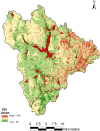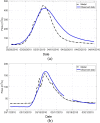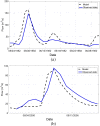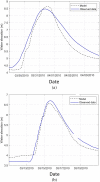Flood risk in past and future: A case study for the Pawtuxet River's record-breaking March 2010 flood event
- PMID: 38021417
- PMCID: PMC10645579
- DOI: 10.1111/jfr3.12655
Flood risk in past and future: A case study for the Pawtuxet River's record-breaking March 2010 flood event
Abstract
In March 2010, a sequence of three major rainfall events in New England (United States) led to a record-breaking flooding event in the Pawtuxet River Watershed with a peak flow discharge of about 500-year return period. After development of hydrological and hydraulic models, a number of factors that played important roles in the impact of this flooding and other extreme events including river structures (reservoirs, historical textile mill dams, and bridges) were investigated. These factors are currently omitted within risk assessments tools such as flood insurance rate maps. Some management strategies that should be considered for future flood risk mitigation were modeled and discussed. Furthermore, to better understand possible future risks in a warmer climate, another extreme flood event was simulated. The synthetic/hypothetical storm (Hurricane Rhody with two landfalls) was created based on the characteristics of the historical hurricanes that severely impacted this region in the past. It was shown that while the first landfall of this hurricane did not lead to significant flood risk, the second landfall could generate more rain and flooding equivalent to a 500-year event. Results and the methodology of this study can be used to better understand and assess future flood risk in similar watersheds.
Keywords: HEC‐RAS; climate change; flood risk; hurricane; river flooding.
© 2020 The Authors. Journal of Flood Risk Management published by Chartered Institution of Water and Environmental Management and John Wiley & Sons Ltd.
Figures



















References
-
- Abbe, T. B. , & Montgomery, D. R. (2003). Patterns and processes of wood debris accumulation in the queets river basin, Washington. Geomorphology, 51(1–3), 81–107.
-
- Ahmad, A. , El‐Shafie, A. , Razali, S. F. M. , & Mohamad, Z. S. (2014). Reservoir optimization in water resources: A review. Water Resources Management, 28(11), 3391–3405.
-
- Anderson, J. R. (1976). A land use and land cover classification system for use with remote sensor data (Vol. 964). Washington, DC: US Government Printing Office.
-
- Barnes, H. H. (1967). Roughness characteristics of natural channels, Number 1849. Washington, DC: US Government Printing Office.
-
- Bednarek, A. T. (2001). Undamming rivers: A review of the ecological impacts of dam removal. Environmental Management, 27(6), 803–814. - PubMed
LinkOut - more resources
Full Text Sources
Miscellaneous
